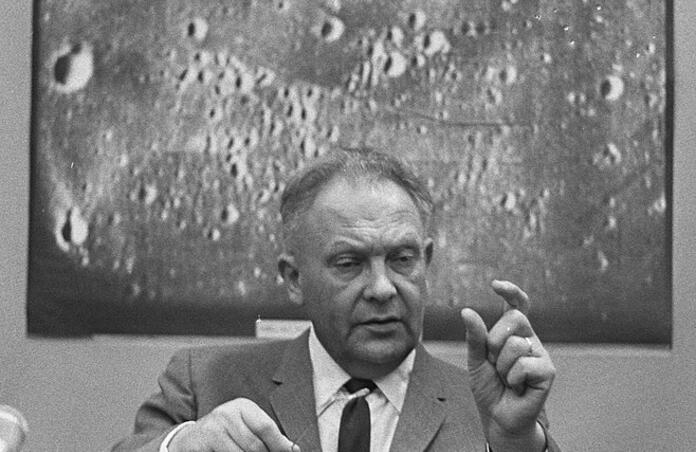Gerard Kuiper

This week contains the 118th birthday for Dutch-American astronomer Gerard Kuiper [1905-1973]. Considering his many achievements, Kuiper was more important than any other individual, in establishing modern planetary science. After receiving his astronomy degrees in Holland, he came to the United States in 1933. He went to Lick Observatory (University of California) in 1933, Harvard College Observatory (Harvard University) in 1935, and Yerkes Observatory (University of Chicago) in 1937, and also became a naturalized U.S. citizen in 1937. Kuiper discovered Miranda (1948), a moon of Uranus, and Nereid (1949), a moon of Neptune. He discovered that Saturn's moon Titan had a methane atmosphere in 1944, and also discovered that the atmosphere of Mars is mostly carbon dioxide. Kuiper moved to the University of Arizona in 1960, where he founded the Lunar and Planetary Laboratory, and was a consultant on selecting lunar landing sites for the Apollo missions. He was also the pioneer of Airborne astronomy, using a NASA Convair 990 for infrared astronomy above 40,000 feet, beginning in 1967. After his death, NASA dedicated the Kuiper Airborne Observatory (KAO) in 1975, which remained in service until 1995. The Stratospheric Observatory for Infrared Astronomy (SOFIA), the KAO replacement, began routine science observations in 2010, and terminated operations in fall of 2022. Airborne astronomy is perhaps Gerard Kuiper's greatest legacy, although no new airborne telescopes are in the works, so far as I know, after the demise of SOFIA Stratospheric Observatory for Infrared Astronomy.He also had amazing eyesight. Kuiper could see stars as dim as magnitude 7.5, by naked eye, where the average limit for human eyes is about magnitude 6.0. So Kuiper could see stars about 4 times dimmer than normal. During WWII, There was a small secret operation, called ALSOS, an offshoot of the larger secret Manhattan project. The original mission for ALSOS was to figure out how far along the German atomic bomb project had gone. But when the war ended, their focus shifted to recovering records, and German atomic bomb scientists (much like the more famous Operation Paperclip, which scooped up German rocket scientists & engineers before the Russians could get them). Kuiper, who spoke fluent German, was recruited into the project, from his post at Yerkes, and went to Germany, late in the war. While in Germany, immediately after the war-ending truce had been signed, Kuiper discovered the whereabouts of Max Planck [1858-1947]. But Planck was beyond the American front line at the Elbe River, and in the zone about to be over-run by revenge-minded Soviet troops. So Kuiper commandeered a jeep, and a couple of unidentified soldiers, ran off into the apocalyptic no-man’s land between the armies, rescued Planck and his wife, and brought them back within American lines. Planck was by then 87 years old, and one of the great “elder statesmen” of physics, in poor health, and had gone through difficult times in Germany, due to his lack of arduous support of the Nazi regime. And Max Planck's son, politician Erwin Planck [1893-1945] was executed by the Nazi regime, for his involvement in the 1944 bomb-plot to assassinate Adolf Hitler [1889-1945]. No doubt his fate would have been much more difficult in the hands of the Russians. The picture of Kuiper is dated 29 August 1964, and comes from the Dutch National Archives, via Wikipedia. The Dutch caption reads: “Aankomst prof. Kuiper op Schiphol, prof. Kuiper bij de maanfotos”, but I can’t read Dutch.
Reposted from Tim Thompson, Retired Chief Astronomer, NASA JPL
Sources
https://en.wikipedia.org/wiki/Gerard_Kuiper (Wikipedia)
https://solarsystem.nasa.gov/.../gerard-kuiper-1905-1973/ (NASA Solar System Exploration) https://www.lpl.arizona.edu/.../points-of.../founding/kuiper (Lunar and Planetary Laboratory - University of Arizona)
https://www.newnetherlandinstitute.org/.../gerard-peter.../ (New Netherlands Institute) http://www.nasonline.org/.../memoir-pdfs/kuiper-gerard.pdf (Biographical memoir, 39-page PDF - National Academy of Sciences)
https://blogs.scientificamerican.com/.../gerard-kuiper-s.../ (Scientific American on Kuiper rescuing Planck during WWII)
https://www.lindahall.org/.../scientist-of.../gerard-kuiper (Linda Hall Library, Scientist of the Day, 7 December 2020)
https://www.youtube.com/watch?v=W-ekSkAX9Cg (The History Guy on Kuiper rescuing Planck during WWII, 11 minute video)
http://scihi.org/astronomer-gerard-kuiper/ (“Modern Planetary Science with Gerard Kuiper” - SciHi Blog, 7 December 2021)
https://en.wikipedia.org/wiki/Kuiper_Airborne_Observatory (Kuiper Airborne Observatory, KAO - Wikipedia)
https://en.wikipedia.org/.../Stratospheric_Observatory... (Stratospheric Observatory for Infrared Astronomy - Wikipedia)
https://en.wikipedia.org/wiki/Alsos_Mission (Alsos Mission - Wikipedia) https://en.wikipedia.org/wiki/Operation_Paperclip (Operation Paperclip - Wikipedia)
https://commons.wikimedia.org/.../File:Gerard_Kuiper... (Photo source - Wikimedia)
